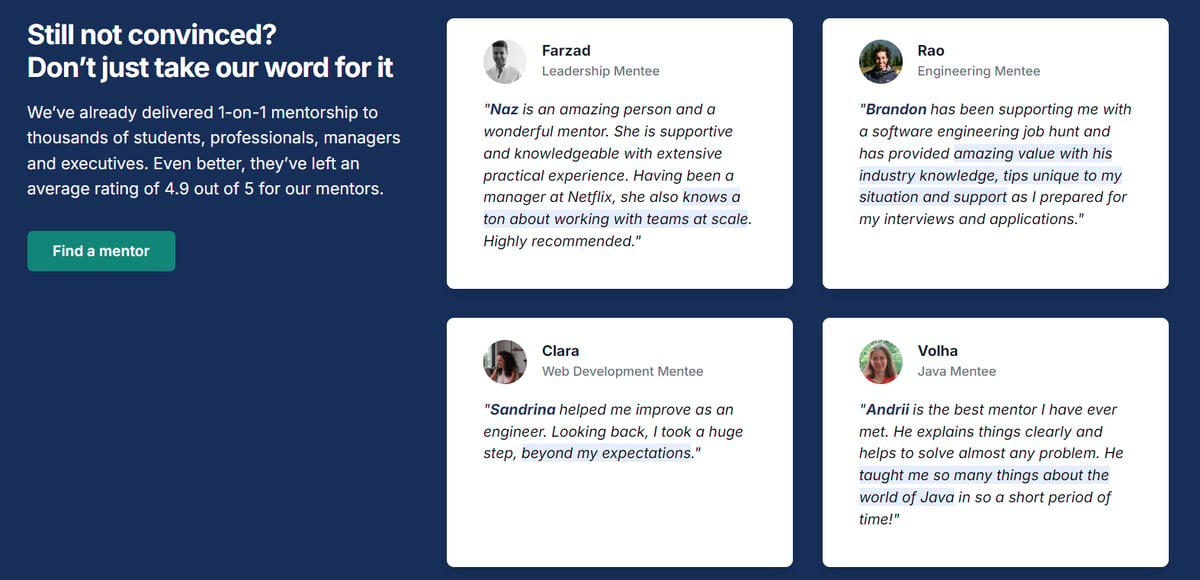Helpful summary
- Why You Can Trust Us: We have firsthand experience mentoring numerous executives, and improving onboarding outcomes. Thousands of professionals, including executives, have benefited from our mentorship.
- Why This Is Important: Proper executive onboarding ensures executives focus on their responsibilities, reduces turnover, boosts morale, and enhances job satisfaction. It equips executives to handle large-scale projects efficiently and align quickly with company goals.
- Action Points: Implement a structured onboarding process including pre-onboarding, actual onboarding, training, and transition phases. Ensure continuous mentorship, clear communication, and alignment with company culture.
- Further Research: Explore effective mentoring strategies and tools to complement the onboarding process. Investigate case studies on successful executive onboarding from companies like Google and Johnson & Johnson.
Want to learn how to onboard your new executives?
Executives hold the most important roles in your company. They are thoughtful, they take initiative, and they understand how to leverage your employees’ potential.
And yet, they still can’t do everything themselves. Nor should you expect them to.
Once you hire the right executive, the process doesn’t end there. You must also ensure they are sufficiently prepared for their new role. When it comes to executive onboarding, you must bridge the gaps in understanding that they need to do their job effectively.
This MentorCruise guide will discuss what executive onboarding is, its importance, steps on how to do it, and some best practices. Let’s get to it.
Why listen to us?
Our mentors have assisted numerous businesses in onboarding new hires, including executives, through the power of mentorship. Our clients have effectively integrated new blood in backbone roles.
Our case studies and success stories show how mentorship improves onboarding by enhancing leadership skills and fostering better team integration. Moreover, we’ve already delivered 1-on-1 mentorship to thousands of students, professionals, managers, and executives.

What is executive onboarding?
Executive onboarding is the process of hiring new executives and integrating them into your company’s culture. It also involves making them familiar with the mission of your organization.
Executive onboarding programs provide these new hires with the most critical information they ought to know to do their job well, including company policies and protocols.
Why is it important?
Executive onboarding is important for these reasons:
- It allows the newly hired execs to focus on their responsibilities: With an effective executive onboarding process in action, they can begin performing their duties right away.
- It reduces turnover rates: The processes of recruitment, hiring, and training newly hired execs can waste a lot of your company’s resources. With a formal onboarding process that sets clear expectations, these executives can adjust to their new roles better, thereby reducing turnover rates.
- It boosts employee morale and job satisfaction: The executive team’s morale is just as vital as that of the rest of the company. If your executive team members have the resources to perform well at their jobs, they are more likely to be satisfied with their position.
- It helps them take on large-scale projects more quickly and efficiently: A good executive onboarding process makes it easier for them to start propagating major changes. Thus, they can start pursuing your company’s broader goals right away.
The executive onboarding process
Most executive onboarding processes have five phases.
1. Goal-setting: Establish clear expectations and objectives for the new executive
Goal-setting is one of the first steps in the executive onboarding process. Here, you must establish clear expectations and objectives for your new executive.
It also involves defining key performance indicators (KPIs), aligning personal goals with the strategy of your company, and setting both short-term and long-term targets.
Effective goal-setting makes sure the executive understands their role very well, prioritizes tasks efficiently, and contributes to organizational success.
ClickUp shares how they asked CEOs, people managers, and company leaders for their insights on how they onboard new hires, including executives. These individuals assign mentors, provide welcome kits, and set up initial meetings to discuss role-specific expectations and KPIs. As a result, executives align more quickly with the overall company strategy.
2. Pre-onboarding: Discuss responsibilities and introduce them to the team
Before the formal onboarding, there has to be a pre-onboarding process. This stage starts as soon as a new executive is hired and continues until the moment they begin working in your company.
During this phase, their roles and responsibilities discussed during the interview round should be reiterated. Your new execs will undergo thorough assessments and evaluations to know their relevant strengths, and what tasks and goals they will eventually take ownership of.
Google's pre-onboarding process is designed to ensure new employees, including new executives, are fully prepared and integrated even before their first official day. They go through automated pre-onboarding tasks, workspace and technology setup, and initial team introductions.
3. Onboarding: Clarify task ownership and responsibilities between your new executives and their team
The next step is the actual onboarding process. This is the beginning of a new executive’s daily work experience in the company. The executive will be formally introduced to their direct reports and the rest of the team members as they transition to their new role.
This phase also clarifies task ownership, and roles and responsibilities between your new executive and their teammates.
To better illustrate this step, let’s take a look at Google once again. Google’s onboarding process for new executives is structured to integrate them smoothly into the company’s daily operations. They go through role and responsibility clarification, a mentorship program, team integration and networking, continuous feedback and check-ins, and cultural immersion.
4. Training: Ensure your new executives know how to use your tools and can collaborate with others
Even if your new employees are highly skilled, they often still need training.
You must ensure your new executive knows how to use your technological tools, completes paperwork, collaborates with other executives and board members, understands the current team’s strengths and weaknesses, and aligns with the organization and its goals as a whole.
Johnson & Johnson best exemplifies this step. Its executive onboarding process includes a comprehensive training program tailored to the needs of each new executive. For instance, training for new execs is different from that of its other hires. Executives also go through focused training and long-term integration.
5. Transition: New executives take full ownership of their duties
This is the final step in the executive onboarding process. Here, your new hire slowly transitions until they are fully familiar with their role and require no assistance.
In this stage, your new executives take full ownership of their duties and goals. It’s the time for them to foster deeper interpersonal relationships with other executives and team members. You can feel confident as they start representing your company, showcasing the skills and specialties they specified during the interview.
For example, during this phase, you can build and enforce a 100-day plan where new executives are provided with a detailed transition plan, spanning 100 days, tailored to their specific roles and needs. This plan includes milestones, key stakeholders to meet, and critical projects to focus on.
MentorCruise offers tailored mentorship from experienced professionals who can provide guidance, industry insights, and personalized support to enhance leadership skills and strategic alignment necessary when onboarding new executives.
Best practices when onboarding executives
You can also follow these best practices as you onboard your new executives.
Provide them with the information they need right away
Here is a list of all the things your executives need to know to do their jobs effectively:
- Company manuals and handbooks
- Job descriptions of other executive team members
- Position goals
- Previous achievements of the position
- Calendar of all upcoming company and department events
- Upcoming project due dates
- List of all shareholders and their contact details
- Other necessary information
Give them the chance to engage with your company’s culture
You can schedule lunches or meets and greets where they can interact with the other team members. You may also schedule physical visits at store locations so they can meet store managers or supervisors.
Don’t put a deadline
Executive onboarding doesn’t have a due date. Instead, tailor your program to the requirements of their position and department. There is no one-size-fits-all solution.
Spend as much effort onboarding as you did during hiring
A lot of you may spend so much time and effort recruiting and hiring. While they are crucial, onboarding executives deserve as much attention as those steps.
Overlap the schedules of your new hire and their predecessor
Doing so will allow your new executive to work closely with their predecessor and learn the ropes of the job.
Keep communication lines open
Check with your new hire how well they feel about the onboarding program. This may also involve ensuring they have direct lines of communication with other executives and stakeholders.
Set expectations clear
Don’t hesitate to lay down how fast your company expects them to transition and acclimate to the tasks within their first to second week.
Design an enticing welcome package
You can schedule a welcome ceremony to mark the beginning of the onboarding process. You may also gift them with a welcome package consisting of branded items.
Elevate executive onboarding with MentorCruise
Executive onboarding has many facets, from the pre-onboarding phase to the crucial transition stage. Within these steps, you must also ensure they get introduced well to their teammates, know how to use the company’s tools, and are aware of your vision and goals, among various other things.
If you want your executives to make the most of their new role: connect them with a mentor or coach from MentorCruise. Mentorship in executive onboarding accelerates adaptation, enhances leadership skills, and fosters organizational culture understanding.
Our platform provides a very easy way for your new executives to access and connect with mentors who can help them become more familiar with their new role. Whether it’s about leadership or their career, we have a catalog of mentors who can share their valuable expertise with them.
Navigating our platform is straightforward. We have menus at the top of our website categorizing our mentors according to their specialization. Alternatively, you can go ahead and search for the right mentor yourself. For instance, try searching for “onboarding mentors.”







